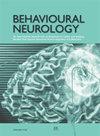Multimodal Brain Tumor Classification Using Convolutional Tumnet Architecture
IF 2.3
4区 医学
Q2 CLINICAL NEUROLOGY
引用次数: 0
Abstract
The most common and aggressive tumor is brain malignancy, which has a short life span in the fourth grade of the disease. As a result, the medical plan may be a crucial step toward improving the well-being of a patient. Both diagnosis and therapy are part of the medical plan. Brain tumors are commonly imaged with magnetic resonance imaging (MRI), positron emission tomography (PET), and computed tomography (CT). In this paper, multimodal fused imaging with classification and segmentation for brain tumors was proposed using the deep learning method. The MRI and CT brain tumor images of the same slices (308 slices of meningioma and sarcoma) are combined using three different types of pixel-level fusion methods. The presence/absence of a tumor is classified using the proposed Tumnet technique, and the tumor area is found accordingly. In the other case, Tumnet is also applied for single-modal MRI/CT (561 image slices) for classification. The proposed Tumnet was modeled with 5 convolutional layers, 3 pooling layers with ReLU activation function, and 3 fully connected layers. The first-order statistical fusion metrics for an average method of MRI-CT images are obtained as SSIM tissue at 83%, SSIM bone at 84%, accuracy at 90%, sensitivity at 96%, and specificity at 95%, and the second-order statistical fusion metrics are obtained as the standard deviation of fused images at 79% and entropy at 0.99. The entropy value confirms the presence of additional features in the fused image. The proposed Tumnet yields a sensitivity of 96%, an accuracy of 98%, a specificity of 99%, normalized values of the mean of 0.75, a standard deviation of 0.4, a variance of 0.16, and an entropy of 0.90.使用卷积 Tumnet 架构进行多模态脑肿瘤分类
最常见和最具侵袭性的肿瘤是脑恶性肿瘤,这种疾病的四级患者寿命很短。因此,医疗计划可能是改善患者福祉的关键一步。诊断和治疗都是医疗计划的一部分。脑肿瘤通常采用磁共振成像(MRI)、正电子发射断层扫描(PET)和计算机断层扫描(CT)成像。本文利用深度学习方法,提出了脑肿瘤的多模态融合成像与分类和分割。使用三种不同类型的像素级融合方法,将相同切片(脑膜瘤和肉瘤的 308 个切片)的 MRI 和 CT 脑肿瘤图像合并在一起。使用提出的 Tumnet 技术对肿瘤的存在/不存在进行分类,并找出相应的肿瘤区域。在另一种情况下,Tumnet 也适用于单模态 MRI/CT(561 个图像切片)分类。所提出的 Tumnet 有 5 个卷积层、3 个带 ReLU 激活函数的池化层和 3 个全连接层。MRI-CT 图像平均法的一阶统计融合指标为:组织 SSIM 为 83%,骨骼 SSIM 为 84%,准确度为 90%,灵敏度为 96%,特异度为 95%;二阶统计融合指标为:融合图像的标准偏差为 79%,熵为 0.99。熵值证实了融合图像中存在附加特征。建议的 Tumnet 灵敏度为 96%,准确度为 98%,特异度为 99%,归一化平均值为 0.75,标准偏差为 0.4,方差为 0.16,熵为 0.90。
本文章由计算机程序翻译,如有差异,请以英文原文为准。
求助全文
约1分钟内获得全文
求助全文
来源期刊

Behavioural Neurology
医学-临床神经学
CiteScore
5.40
自引率
3.60%
发文量
52
审稿时长
>12 weeks
期刊介绍:
Behavioural Neurology is a peer-reviewed, Open Access journal which publishes original research articles, review articles and clinical studies based on various diseases and syndromes in behavioural neurology. The aim of the journal is to provide a platform for researchers and clinicians working in various fields of neurology including cognitive neuroscience, neuropsychology and neuropsychiatry.
Topics of interest include:
ADHD
Aphasia
Autism
Alzheimer’s Disease
Behavioural Disorders
Dementia
Epilepsy
Multiple Sclerosis
Parkinson’s Disease
Psychosis
Stroke
Traumatic brain injury.
 求助内容:
求助内容: 应助结果提醒方式:
应助结果提醒方式:


